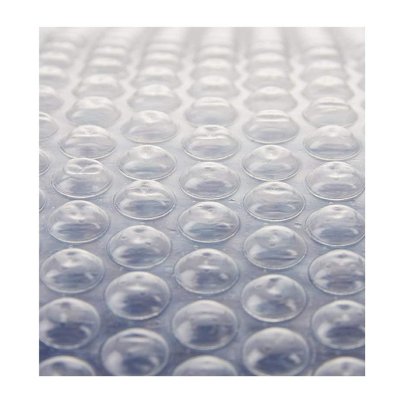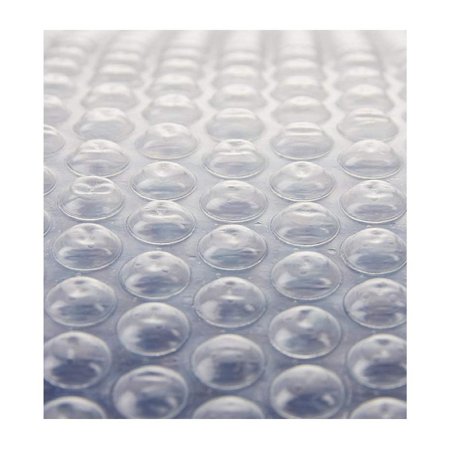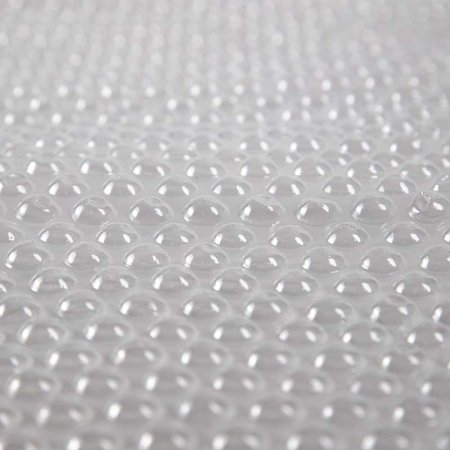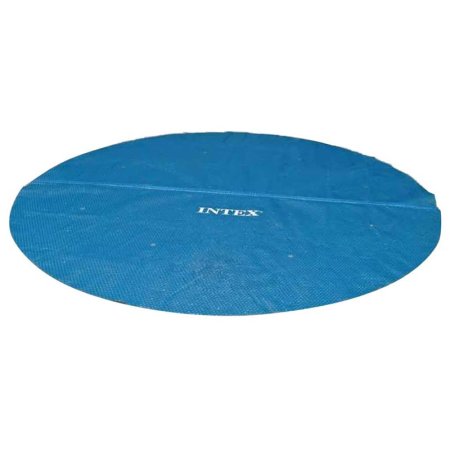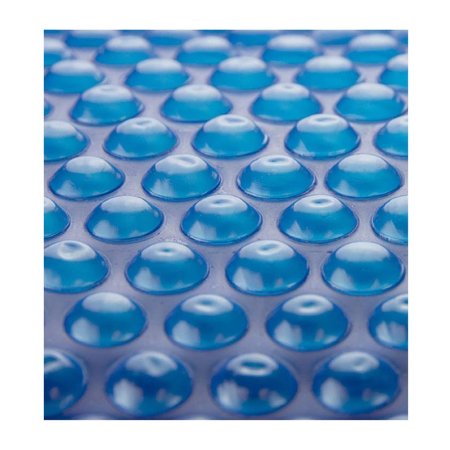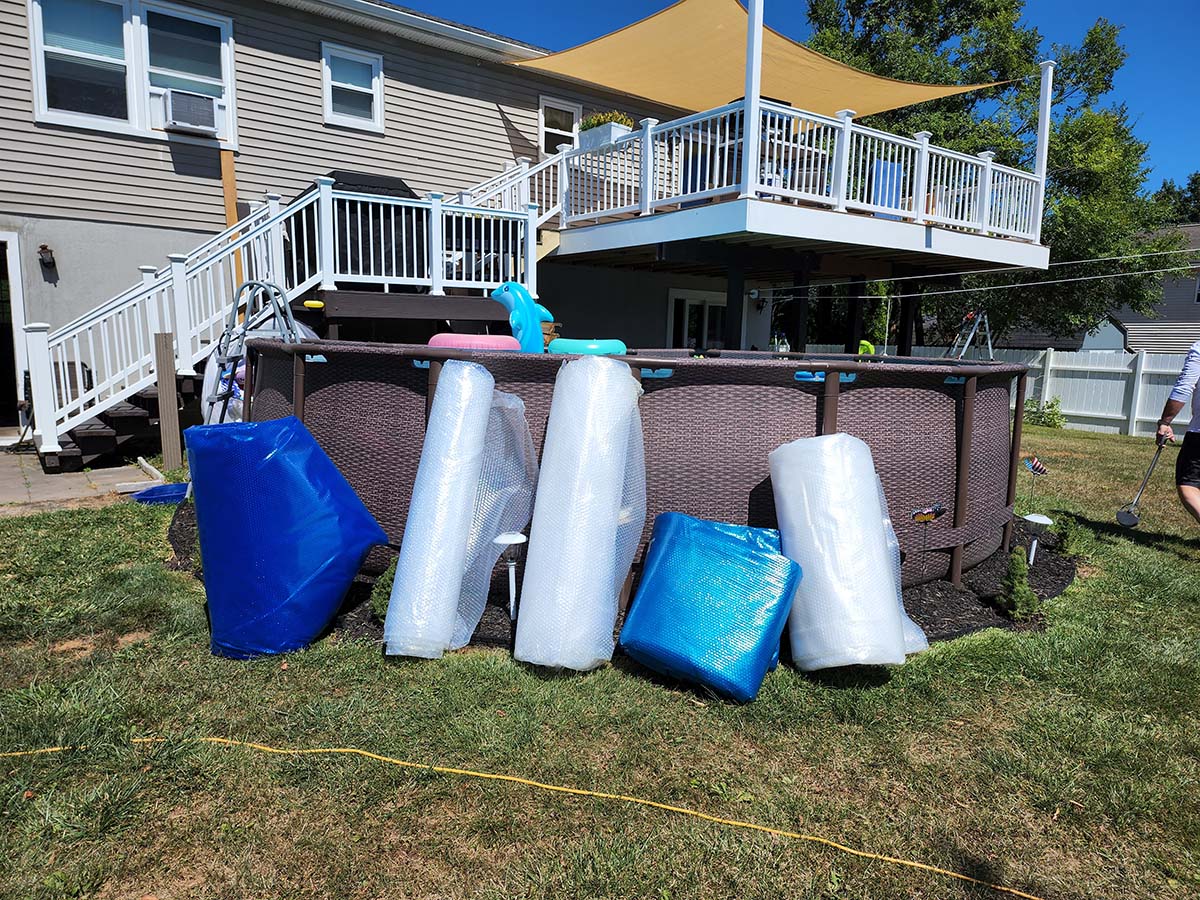
We may earn revenue from the products available on this page and participate in affiliate programs. Learn More ›
Solar pool covers absorb the sun’s heat and transfer it to the water, warming either above-ground or inground pools to a comfortable temperature for swimming. Made of vinyl, polyethylene, or polypropylene, the best solar pool covers also insulate the pool when the sun goes down. Our top pick was the Sun2Solar pool cover, with its durable material and range of size options.
A solar pool cover can lower the cost of heating a pool by as much as 70 percent because the pool heater won’t have to run as much to maintain the set pool temperature. They prevent evaporation, effectively lowering the water bill. They keep dirt, debris, and insects out of the water. Additionally, the best solar pool covers block ultraviolet (UV) radiation that breaks down the pool chemicals, producing free chloramines, which can irritate a swimmer’s eyes and skin.
We even performed hands-on testing with the following solar pool covers to ensure that we suggested only the top products.
- BEST OVERALL: Sun2Solar 1200 Series Crystal Clear Round Cover
↓ Jump to Review - RUNNER-UP: Blue Wave 12-Mil Round Solar Blanket
↓ Jump to Review - BEST BANG FOR THE BUCK: Intex 18 Foot Round Easy Set Solar Cover
↓ Jump to Review - UPGRADE PICK: Sun2Solar 1600 Series Ultimate Blue Round Solar Cover
↓ Jump to Review - BEST FOR UV RAYS: Doheny’s 1600 Standard Series Blue Solar Cover
↓ Jump to Review
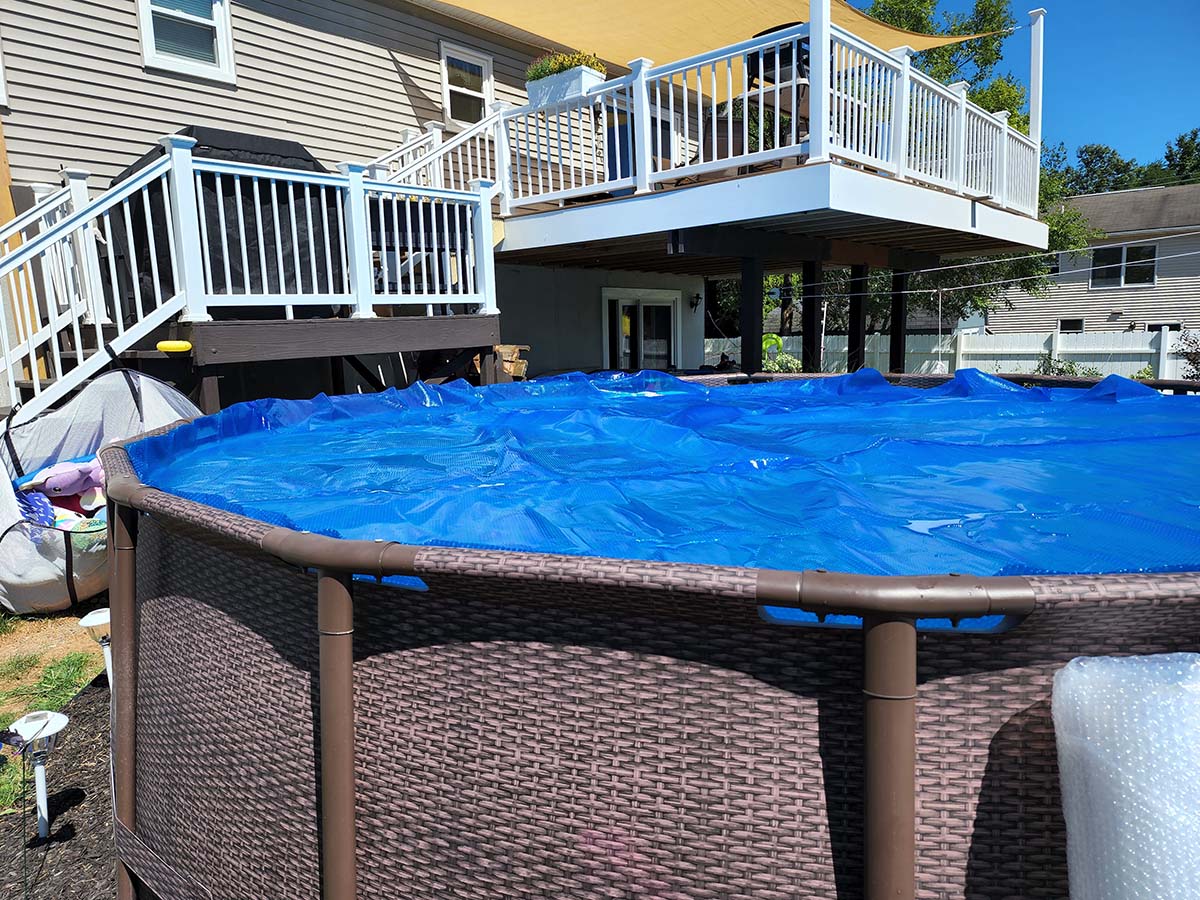
How We Tested the Best Solar Pool Covers
We wanted to ensure that we were suggesting the best solar pool covers we could find, so we performed hands-on testing to round them all up.
The first thing we tested was how easy each pool cover was to install. All of them were relatively easy to put on with one person, but they required two people to remove them without making a mess. We checked their fit to see how much extra material each included. Then, we allowed them to sit for an hour in direct sunlight in midafternoon to see how much the water temperature moved.
Testing these solar pool covers was quite an endeavor, especially outside of a controlled lab or testing facility. We did our best to stick with relatively consistent temperatures and sun exposure and tried to track temperature rise and drops throughout the day. What we found was that each of the pool covers increased the temperature 4 to 5 degrees Fahrenheit in 2 pm sun on 89- to 92-degree Fahrenheit days. Hitting 90-degree Fahrenheit water temperatures was the norm.
Once we knew that each cover would do what it was designed to do, we compared their materials and construction, and we gave each an award based on its strengths.
| Testing Stats | |
| Products tested | 10 |
| Time spent testing | 1 hour each |
| Tests performed | 8 |
| Price range | $50 to $140 |
Our Top Picks
The following recommendations take into account the above shopping considerations as well as overall quality and value. Keep reading to discover some of the top options to warm up above-ground or inground pools.
Best Overall
Sun2Solar 1200 Series Crystal Clear Round Cover
Pros
- Comes in a range of sizes; suitable for most pool sizes
- Has extra material for custom cuts
- Allows plenty of sunlight penetration; great for heat
Cons
- Might not help with chlorine consumption
Product Specs
- Material: Polyethylene
- Color: Clear
- Thickness: 12 mils
Our Ratings: Ease of Use 5/5; Durability 5/5; Performance 5/5; Value 5/5
This clear solar cover’s goal is to collect and retain heat, and it does just that at 12 mils thick with a rigid polypropylene construction. Because it is clear, sunlight can go all the way to the depths of the pool, so even the deep end is warm. The thickness will resist tears and other damage, too.
The particular cover comes in a range of sizes—from 12 feet in diameter to 33 feet in diameter—so users can get an exact fit for their swimming pool. If it’s not a perfect fit, this cover can be cut down because all sizes come with an extra 2 to 4 inches of material.
We tested the 18-foot Sun2Solar 1200 Series Crystal Clear Round Cover, and it proved to be top quality during testing. We liked that it was very easy to put on the pool but still thick enough to be durable (12 mils). It also appeared to allow plenty of sunlight penetration—great for heat but possibly bad for chlorine consumption. The Sun2Solar 1200 Series did come with considerably more material than stated, so we believe most folks will have to trim it to fit their pools, but it’s simple to cut without being easy to tear.
Get the Sun2Solar 1200 Series solar pool cover at Amazon or Walmart.
Runner-Up
Blue Wave 12-Mil Round Solar Blanket
Pros
- Less clear than other clear covers; blocks more UV light
- Comes in multiple round sizes to fit a range of pool sizes
- Allows for custom cut to fit many different pool shapes
Cons
- Some bubbles may start to pop over time
Product Specs
- Material: Polymer
- Color: Clear
- Thickness: 12 mils
Our Ratings: Ease of Use 5/5; Durability 4/5; Performance 4.5/5; Value 5/5
Blue Wave’s 12-mil-thick solar pool cover is durable enough to resist tears and other damage. Its translucent blue color blocks UV radiation, and a thick layer of air bubbles does a superior job of absorbing, transferring, and retaining heat.
Round solar covers like this Blue Wave product aren’t just for round swimming pools. They’re a good pick for custom-shaped pools because they can be trimmed to fit more easily than round or oval covers. For custom pools, choose a cover that fits over the entire pool, then trim it to the right shape. This particular cover comes in five round sizes, including 15 feet, 18 feet, 24 feet, 28 feet, and 30 feet.
The Blue Wave 12-Mil Solar Blanket did a great job of absorbing sunlight. And while it’s technically clear, it’s noticeably less clear than other covers, allowing it to block at least some UV light. At 12 mils, we were able to roll it out and unfold it with one person, and it started to lay flat as the sun warmed it. It did come with extra material for our 18-foot pool, which means getting a custom fit should be a breeze for most pool owners.
Get the Blue Wave solar pool cover at Amazon or Walmart.
Best Bang for the Buck
Intex 18 Foot Round Easy Set Solar Cover
Pros
- Holes allow air to escape and drain water from the top of the cover
- Finished edges for smooth handling
- Blue color helps fight UV ray penetration
Cons
- No extra material; may not fit all pool sizes
Product Specs
- Material: Polyethylene
- Color: Blue
- Thickness: 8 mils
Our Ratings: Ease of Use 5/5; Durability 4/5; Performance 5/5; Value 5/5
Intex’s 8-mil-thick solar pool cover is a good choice for easy set and framed above-ground pools, though it will fit any circular pool with a diameter of 18 feet. This affordable solar blanket has a moderate level of UV resistance that helps to prevent evaporation during the day, while the lightweight cover aids heat retention at night by insulating the pool against dropping nighttime temperatures.
The circular solar pool cover has thick air bubbles to help the absorption and transfer of heat from the sun into the water, raising the temperature slowly throughout the day. It is designed with a series of holes in the cover that some users mistake for a defect, but these holes are intentionally included to help release trapped air and drain water from the top of the cover.
Full disclosure: The Intex was one of our favorite solar covers in the test. It’s not thick, but the blue color helps keep UV rays out while allowing heat in. Also, the holes in the field of the cover are a nice touch, as this was the only cover to actually lay flat. It fit our pool perfectly, and it has finished edges for a smoother feel. That was great for us, but folks looking to custom cut theirs to an 18-foot pool won’t have much material to work with.
Get the Intex solar pool cover at Amazon, The Home Depot, or Target.
Upgrade Pick
Sun2Solar 1600 Series Ultimate Blue Round Solar Cover
Pros
- Clear material allows plenty of sunlight to get through and warm the pool
- Durable thickness makes this cover more difficult to tear
- Fits round pools well; available in multiple sizes
Cons
- Thickness made it slightly heavier and difficult to take on and off
Product Specs
- Material: Polyethylene
- Color: Blue
- Thickness: 16 mils
Our Ratings: Ease of Use 4/5; Durability 5/5; Performance 5/5; Value 5/5
Sun2Solar’s pool cover fits round swimming pools from 10 feet to 33 feet in diameter. Made of 16-mil-thick polyethylene, this cover has a thick layer of air bubbles that does a superior job of collecting, transferring, and retaining heat. The cover also insulates the pool at night and reduces evaporation.
The translucent material lets in a lot of sunlight but doesn’t do a great job of blocking UV light. Since this round solar pool cover is thick, it’s a little more difficult to roll, fold, and store. But the increased durability and heat absorption make it worth the trouble.
We did find that the Sun2Solar 1600 Series was a little less pliable than other pool covers, but the durability appears to be worth it. We did find that leaving it in the sun for a bit made it a bit easier to stretch over the pool, and it appeared to do a great job of letting sunlight in to warm the water. It did have a bit less extra material than the other covers, so it may be best for round pools only—custom cuts might not fly.
Get the Sun2Solar 1600 Series solar pool cover at Amazon or Walmart.
Best for UV Rays
Doheny’s 1600 Standard Series Blue Solar Cover
Pros
- Thick and durable material can last several seasons
- Blue prevents UV rays from penetrating as readily; good for maintaining chlorine
- Additional pockets should help insulate better overnight
Cons
- Feels slightly heavier than the rest; more difficult to move around
Product Specs
- Material: Polyethylene
- Color: Blue
- Thickness: 16 mils
Our Ratings: Ease of Use 3.8/5; Durability 5/5; Performance 5/5; Value 5/5
Folks looking to protect their pool against UV rays and the itchy chloramines they cause should consider Doheny’s Clear-Tek Micro-Bubble Solar Cover. This pool cover features microbubbles and a blue layer of polyethylene to prevent UV rays from breaking down the chlorine so quickly.
This cover comes in several sizes, including 18, 24, 38, and 30-foot round, as well as some oval sizes. The 16-mils polyethylene is tough, allowing users to take it on and over without worrying about tears or damage. It does come with some extra length, so cutting it to size will be a breeze.
Our test revealed that this solar pool cover is tough. We appreciated the deep blue color as we know it’ll prevent UV rays from making their way to our chlorine. The microbubbles appeared to work just as well at keeping the cover afloat, but there’s an added benefit of more insulating pockets to keep the pool warmer overnight. The only possible complaint is that the extra bubbles and thicker material do make this cover slightly heavier than the rest.
Get the Doheny’s solar pool cover at Amazon.
Jump to Our Top Picks
What to Consider When Choosing a Solar Pool Cover
These solar blankets can be used on a range of different pools, including both above-ground and inground swimming pools of varying sizes and shapes. The following are some considerations to keep in mind when choosing a solar pool cover, including the pool dimensions, material, thickness, and color.
Pool Dimensions
Swimming pool size is a top consideration since a proper fit allows for optimal function. To get the best heat transfer from the sun, the cover should be large enough to sit on the surface of the water.
The shape of the pool is important, too. Solar covers are made to fit a variety of swimming pools, so shoppers can look for an oval solar cover, a cover for their rectangular pool, or even a compact solar blanket made to fit square pools. If the pool is a custom shape, shoppers may want to buy a cover larger than the pool so that the cover can be trimmed to fit.
Material
Solar pool covers are usually made of vinyl, polyethylene, or polypropylene.
- Vinyl is durable and resistant to tears and sun damage. Vinyl covers are a good option for pool users who want to be able to remove a cover quickly without having to be too careful not to tear it.
- Polyethylene is more lightweight. Covers made of polyethylene are affordable and effective at heat transfer. They can be prone to tearing, though, especially if the cover has a thickness of 12 mils or less.
- Polypropylene is thicker than polyethylene and less flexible. Covers made of polypropylene are durable and block a lot of UV radiation, but they can be more difficult to roll and fold.
Thickness
Thicker solar pool covers absorb more heat from the sun, and they are also more resistant to rips, tears, and sun damage. Solar pool cover thickness is measured in mils. One mil is equal to 0.0001 inches. Common cover thicknesses range from 6 mils to 16 mils. Due to their thickness, these pool covers can be heavier and harder to fold up.
Color
Color is more than just an aesthetic choice for a solar pool cover. The color of a solar pool cover also determines how it functions.
- Clear solar covers allow a lot of pool-warming sunlight to pass through to the water. They retain heat well and are a great insulator at night, but they do not block UV rays that break down chlorine.
- Clear-top/dark solar covers absorb the sun’s heat and transfer it to the water while blocking some UV rays. This helps slow the production of skin-irritating chloramines.
- Dark solar covers block a large portion of UV radiation and absorb the sun’s heat well, warming the pool quickly.
- Translucent solar covers work like a clear solar pool cover, but they block more UV radiation from reaching the pool water and heat the water faster.
Air Bubbles
The best solar pool covers have a side covered with small air bubbles and resemble a giant sheet of bubble wrap. These air bubbles trap heat from the sun and radiate it into the water. When the sun goes down, the bubbles also act as insulators to prevent heat loss.
Solar covers that do not have air bubbles can still trap and transfer heat, but they’re not as efficient. The thicker the air bubbles, the more tear-resistant the pool cover is. Thicker air bubbles also do a better job of insulating the pool at night.
UV Resistance
A solar pool cover’s UV resistance depends on its material, color, and the thickness of the air bubbles.
- Low UV-resistance solar covers are thinner than 10 mils. They’re typically clear and made of lightweight polyethylene. While they will heat the pool, they’ll require a chlorine stabilizer to reduce the production of chloramines.
- Medium UV-resistance solar covers are the most common. They range from 10 mils to 14 mils thick and are typically translucent blue or gray. They’re usually made of polyethylene or polypropylene.
- High UV-resistance solar pool covers fall into two categories: bubbles or no bubbles.
- Covers with bubbles are typically 14 to 16 mils thick and translucent or clear on top with a dark-colored underside. They are usually made of vinyl or polypropylene.
- Covers without bubbles are thin, vinyl, and dark-colored to absorb heat from the sun. They block a lot of UV radiation but are not as effective at transferring heat to the pool water.
The Advantages of Using a Solar Pool Cover
The main purpose of a solar pool blanket is to help the pool water gradually increase in temperature over the day and keep the pool protected at night for better heat retention when the sun is down. While these solar pool covers may not have the same heat-production potential as an electric or gas pool heater, they are much more affordable.
However, the initial cost isn’t the only way they can help the user save money. Solar pool blankets also reduce the amount of water that evaporates from the surface of the pool throughout the day and night. This helps to prevent the breakdown of chlorine into harmful free chloramines, reducing the amount of chlorine required throughout the swimming season.
- A solar blanket helps to increase the temperature and heat retention of the water by absorbing and magnifying the sun’s rays.
- These solar pool covers are more affordable than investing in a pool heater.
- The evaporation of pool water and subsequent increase of chloramines is slowed with a solar blanket.
FAQs
Still have questions about how a solar blanket works? Here are some common questions and their answers.
Use the solar pool cover any time the pool is not being used or cleaned. At night, the pool cover can help to prevent the loss of heat from the water.
Solar pool covers don’t impact the way the pool pump or filter functions, so they can be run with the cover on.
It’s a good idea to wait at least 1 hour after adding chemicals before putting the solar cover back on the pool. This ensures that the chemicals are adequately mixed throughout the pool water and won’t damage the cover.
The easiest way to remove a solar pool cover is to roll it up. Some pools have rollers on the side to remove the cover without damaging it.
Solar pool covers can be cleaned with a soft brush and rinsed with a hose.
Roll up the solar pool cover and fold it at least twice so the cover can fit into a protective bag, like a contractor’s garbage bag. Store the bag in a cool, dark location like a shed or a garage.
Meet the Tester
Tom Scalisi is a freelance writer specializing in the home design, construction, tools, and automotive industries. He has been involved in the trades for over 15 years as both a contractor and a commercial building mechanic. His work has been featured on This Old House, Family Handyman, and Forbes as well as his own pest control blog. As a lover of all things tools, construction, and DIY, he’s always looking for new tools and techniques while also sharing his knowledge with the DIY world.
Additional research provided by Timothy Dale.
